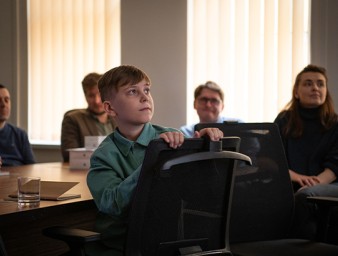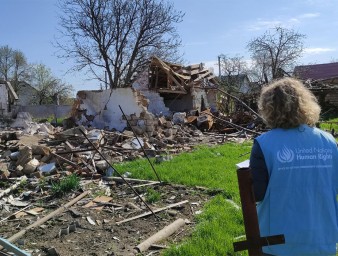In Vienna, UN human rights official briefs OSCE on Ukraine
08 September 2014

After a visit to Ukraine, Assistant-Secretary General for human rights, Ivan Šimonovic, addressed the Permanent Council of Organization for Security and Co-operation in Europe (OSCE) at a special session on Ukraine. Here is the text of his statement.
Statement to the OSCE Permanent Council
Special session on Ukraine
Ivan Šimonović
United Nations Assistant Secretary-General for Human Rights
8 September 2014
Vienna
Excellencies, ladies and gentlemen,
It is an honour to address the Permanent Council at its special session on Ukraine. In May, I had the opportunity to brief you in an informal meeting. Like then, I am now again returning from a mission to Ukraine.
In this context, I would like to underline the excellent cooperation the UN Human Rights Monitoring Mission in Ukraine enjoys with the OSCE Special Monitoring Mission. While in Kyiv last week, I had the opportunity to meet with Ambassador Apakan, with whom we have strong working relations. Our respective monitors are indeed working in full complementarity with their fellow OSCE colleagues on the ground. In a situation as complex and sensitive as the conflict in Ukraine, it is very important to ensure that our respective messaging is mutually reinforcing.
Excellencies, ladies and gentlemen,
The 5th report of the UN Human Rights Monitoring Mission in Ukraine covers the period from 16 July to 17 August. In my briefing, I will also provide a human rights update since the cut-off date of the report.
Let me begin by stating that with the intensification of the hostilities in eastern Ukraine, the number of people that have been killed has risen dramatically.
The trend is clear and alarming. There is a significant increase in the death toll in the east. Between mid-April and mid-July, the period covered by our first four reports, our human rights monitors registered an average of at least 11 persons being killed daily. During the recent reporting period, they registered an average of 36 persons killed a day. This number continues to increase since the cut-off date of the report. The current registered number of killed is 2,729, or over 3,000 if we include the 298 victims of the MH17 plane crash. Let me add that this number includes killings registered based on available resources, and that the actual number may be significantly higher.
The sharp increase in civilian casualties during the last month is largely due to the intensified fighting, including the use of heavy weaponry and indiscriminate shelling in densely populated areas. In this context, and throughout my mission, I raised the need to ensure respect for the principles of international humanitarian law, including the principles of necessity, distinction and proportionality in the use of force.
At the same time, the armed groups continue to commit abductions, physical and psychological torture, ill-treatment and other serious human rights violations. They abduct people for ransom, for forced labour and in order to use them for exchange for their fighters held by the Ukrainian authorities. The rule of fear and intimidation of the armed groups has been well-documented in our previous reports and continues to this day. The forced mobilisation and threat of the death penalty are additional means to terrorise the population in the territory under their control.
The exact number of people being held by the armed groups is estimated to be more than 460. As some hostages are released, new ones are detained. The ill-treatment and humiliation of hostages has also been well-documented, including in the media.
The woman hostage in Donetsk, forced to wrap herself in a Ukrainian flag and to wear a sign saying “She kills our children”, guarded by an armed man with a machine gun, is spat on and kicked by passersby. The captive Ukrainian soldiers are forced to march down a Donetsk street with their hands tied behind their backs with on-lookers cheering, mocking them. These are acts that fuel more tensions and hatred and deepen the divide within Ukrainian society as a whole. They are also violations of international humanitarian law: all persons deprived of their liberty must be treated humanely, and outrages upon personal dignity are specifically prohibited by the Geneva Conventions.
In some areas armed groups prevented people from leaving the areas where they have their strongholds, using whole towns and cities as human shields. The report also documents how civilians have been killed while using the corridors set up by Ukrainian forces to enable residents to leave the cities currently under blockades. People have been stopped at train stations and prevented from leaving. Displaced people continue to report how they were stopped by armed groups at checkpoints, robbed and intimidated as they tried to leave.
In this context, during my recent mission I was able to raise with representatives of both sides the need to abide by international human rights principles and international humanitarian law. In particular I emphasized the obligations of political and military leaders arising from their command responsibility. I reminded them of their duty to take measures to prevent the commission of crimes and to punish them if they occur, or to face individual criminal responsibility themselves.
Based on assurances of cooperation that I got, the UN Human Rights Monitoring Mission will also be facilitating - together with the ICRC - the exchange of lists of detainees and the provision of information on missing persons between the armed groups and the Government. Regular visits to the detained are also envisaged as an additional human rights and humanitarian law centred confidence building measure. Hopefully the mentioned activities will not only help alleviate human suffering, but also pave the way for meaningful political dialogue and a peaceful settlement of the conflict.
The humanitarian situation in the areas controlled by the armed groups, especially in Luhansk, is worsening dramatically. Residents have been left without water and electricity since the beginning of August. Humanitarian aid sent by the Ukrainian Government on 15 August could not be distributed to the residents in the city because it is still controlled by the armed groups whose leaders have said publicly that they will refuse any aid from the Ukrainian Government. On the other hand, the well-publicized white truck convoy that was sent over the border by the Russian Federation, without the consent of the Ukrainian Government, was able to deliver its cargo. The well-being of the residents of Luhansk has obviously become part of a larger geo-political struggle. This is both a violation of humanitarian principles, as well as humanitarian law.
As the Ukrainian Government regained some areas formerly controlled by the armed groups, there have been some disturbing reports of violations committed by battalions under Government control. These battalions have replaced the police in many of these newly-liberated towns and villages. I acknowledge efforts made by the Government to clarify the legal status of the battalions. However, reports of arbitrary detention, enforced disappearances and torture have been documented in the report. I have met with some of the victims and have made it clear to the authorities that perpetrators need to be held accountable and that the Government must exercise more control over all of its forces, including the volunteer battalions. I received assurances that this will be done.
Some 20,000 residents have returned to their homes in and around Slovyansk. Volunteers and the Government have restored essential services, have cleared away the rubble and unexploded ordinances and are rebuilding areas that have been devastated by months of fighting. Life is beginning to return to normal, as I witnessed first-hand during my visit there last week. Damaged schools have been repaired and are ready for the beginning of the school year. However, many residents of the areas back under the control of the Government fear reprisals, lack confidence that past human rights violations will be investigated, and fear the cycle of impunity will continue. There is also a growing mistrust among the local population against persons who may have collaborated with the armed groups. There needs to be accountability for crimes committed by the armed groups, while at the same time avoiding retaliation. This is essential to overcome divisions and pave the way for reconciliation.
About half of the population of Luhansk and one-third of Donetsk have fled. There are more than 200,000 registered internally displaced people from the east. The actual number of unregistered IDPs may however be two or three times higher. There are also reports of mass influxes of refugees in to Russia. Reportedly, over 800,000 have crossed the border in recent months. Most of these people hoped their displacement would be short-lived and that they would be able to return home by the end of the summer. But as the colder weather approaches and the school year just having begun, this has not happened.
The temporary conditions in which most of internally displaced staying in collective centres are living in, will not be sustainable for much longer. The situation is further exacerbated by the anticipated energy shortages in the country that will likely affect the population as a whole, but could disproportionately affect the IDP population. IDPs residing in temporary shelters, ill-suited for colder temperatures, will be most affected. The limits of the current support to displaced persons, which is primarily based on citizens’ solidarity, may have already been reached, requiring stronger Government and international donor support to protect their social and economic rights.
The escalation of hostilities and opening of a new front in the south-east of Ukraine, including the alleged large scale participation of foreign troops, may cause a new wave of displacement further exacerbating the human rights situation.
Moving from the south-east of Ukraine to Crimea, the displacement to other parts of Ukraine has increased from 11,000 to 17,172 during the reporting period. This sharp increase may be due to a number of factors, including pressure of the changing legal system, uncertainty and fear over the human rights situation and respect of the rights of the Crimean Tatar population, as well as improved registration on the part of those displaced. It will be important to continue to monitor the situation closely.
Excellencies, ladies and gentlemen,
Let me conclude. The conflict dynamics show that a military solution alone cannot solve the problems in eastern Ukraine. As the Ukrainian side increased its strength, through mobilisation and better organisation, the other has responded with the increased deployment of new fighters and more sophisticated weapons, allegedly coming from outside of the country. Every shift of the balance of power is accompanied by an ever higher cost to the civilian population. The price of the escalation of hostilities is being paid by all Ukrainians - regardless of their ethnicity or political affiliation - who have been dragged into this increasingly deadly and destructive conflict.
The damage to the infrastructure, including residences, schools, shops, factories, mines and other businesses from the shelling, and also the sabotage of roads, railway lines, bridges and the like, will also have longer-term repercussions for the recovery of the east and the country as a whole. The conflict drains resources which could be otherwise used on much needed reforms and an improved quality of life for all Ukrainians.
Current top level discussions on the cease-fire are encouraging. However, sustainable peace in eastern Ukraine can only be based on a political settlement that respects the country’s territorial integrity and ensures human rights for all, including the full respect of language and other rights of ethnic minorities. Let us use our respective mandates to support the achievement of such an outcome as soon as possible! Ukraine should be spared of a winter of horrors!
Thank you.




